Wild About Texas – October, 2009
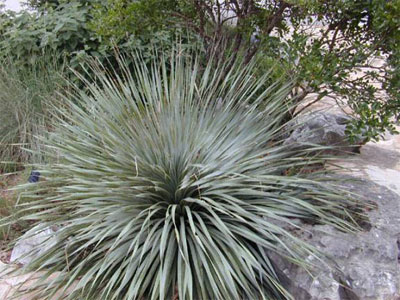
Wheeler’s sotol (Dasylirion wheeleri) is one of the “woody lilies.” (See the unusual flowers of Texas sotol below.) Photo by Joe Marcus.
Native Lilies A-Z
So many of our most elegant native plants occur in the lily family, or, Liliaceae. Many have showy blossoms, some are evergreen, a few are edible and yet others are fatally poisonous. In the field, lilies can be identified as having six petals and flowers that are radially symmetrical (meaning they can be cut into identical halves from any point through the center). Narrow grassy or strap-like foliage emerging from the base of the plant is typical, and many have bulbous or fleshy roots. Taxonomy of this family is contentious, and some botanists put agaves and other plants into the lily family.
Here are a few garden-worthy lilies you may want to know about if you don’t already:
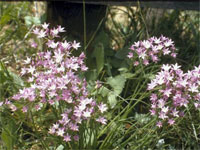
Drummond’s wild onion (Allium drummondii). Robert L. Stone.
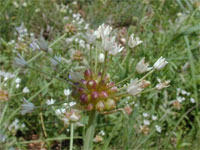
Canada wild onion (Allium canadense) with bulbils. Joe Marcus.
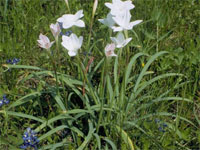
Spring rainlily (Cooperia peduncula). Michael Dana.
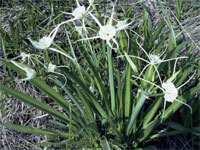
Texas spiderlily (Hymenocallis liriosme). Mrs. W. D. Bransford.
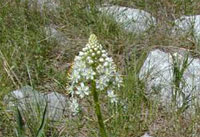
Death camass (Zigadenus nuttallii). Joe Marcus.
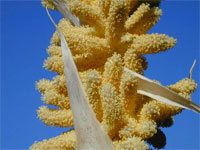
Texas sotol (Dasylirion texanum). Joe Marcus.
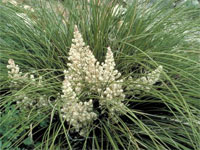
Bear-grass (Nolina texana). Paul Cox.
Onions: Drummond’s onion (Allium drummondii) has fine foliage that shows up in winter and disappears after flowering in late spring. Flowers are light pink to white and have a delicate fragrance contrasting with the sulfurous odor of the leaves. Don’t let them get crowded by other plants during their growing period. Canada wild onion (A. canadense) is a bit more robust, with white to yellow flowers sometimes tinged with pink. Instead of seeds, plants form bulbils (small bulbs) in the flower heads. The bulbils fall to the ground to start new plants. Both species spread vigorously but retreat into the ground from late spring to early winter. Plant in full to partial sun.
Rainlilies: Spring rainlily (Cooperia pedunculata) and fall rainlily (C. drummondii) are so similar they are often mistaken for the same thing. Blooming with creamy white to pink flowers after rains, they can usually be distinguished by the time of year they bloom, although their bloom periods overlap in the middle of summer. They do best in non-irrigated areas. Collect your own to grow from seed. Best in full to part sun in a variety of soil types.
Texas spider-lily (Hymenocallis liriosme) is found in the eastern quarter of the state, where it thrives in marshes and beside streams. It also does well in other areas provided it gets ample water. The showy, clean white flowers contrast dramatically with the dark, shiny green foliage, lending a tropical feel to a garden. Grows in full sun to considerable shade.
Crow poison (Nothoscordum bivalve) is very similar to Alliums but should not be mistaken for them. Crow poison has only four to 12 flowers per cluster, many fewer than the onions, and the bulbs do not smell sulfurous. Blooming both spring and fall, this is a common wildflower, considered by some to be a weed — a pretty one at that! Ranges throughout the state in open sun or light shade.
Death camass (Zigadenus nuttallii), so named for its deadly toxic nature and likeness to the edible wild hyacinth (Camassia sp.), blooms in spring with dense clusters of small white flowers that provide nectar to butterflies. Death camass thrives in prairies and open woods. Plant in partial sun. Tolerates a wide range of soil types.
Sotols: Texas sotol (Dasylirion texanum) of Central and West Texas and Wheeler’s sotol (D. wheeleri) of far West Texas are both excellent for providing strong form as well as graceful movement in a landscape. Considered “woody lilies,” they differ from each other in foliage color. Texas sotol is yellowish-green, while Wheeler’s sotol is blue-gray. I think the flowers look like Cheetos. Provide full to part sun, excellent drainage, and no extra water.
Basket-grasses: Also known as bear-grass, Nolina texana grows typically in dry woodlands under the shade of live oaks and red oaks, but also tolerates full sun. The long, graceful leaves evoke flowing water and work nicely hanging over a wall. Devil’s shoestring, N. lindheimeriana, grows under similar conditions, but is slightly larger with grayer leaves that have very sharp edges, comparable to Pampassgrass. Use caution when handling. Both species are “woody lilies” with evergreen and supple leaves that are ideal for basket making.
Many of these plants are not commonly found in nurseries or garden centers, but diligence may reward you with a few. Some can be purchased from seed and all have been found at the Lady Bird Johnson Wildflower Center’s semi-annual plant sales (although not at every sale). Also keep an eye out for seeds you can collect yourself.
For more information about Texas native plants, visit the Wildflower Center’s website at: www.wildflower.org.
About the author: Andrea DeLong-Amaya is the director of horticulture at the Lady Bird Johnson Wildflower Center in Austin.
